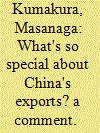| Srl | Item |
| 1 |
ID:
116509


|
|
|
|
|
| Publication |
2012.
|
| Summary/Abstract |
We develop an input-output methodology to estimate how Chinese exports affected the country's total domestic value added (DVA) and employment in the years 2002 and 2007. For every US$1000 dollar of Chinese exports in 2007 (2002), DVA and employment are estimated to be US$591 (US$466) and 0.096 (0.242) person-year, respectively. To implement these estimations, we use hitherto unpublished Chinese government data to construct several completely new datasets, including an input-output table with separate input-output and employment-output coefficients for processing exports, non-processing exports, and output for domestic use. We hypothesize that, in comparison with the export sector, China's domestic sector would be relatively autarkic due to China's history of central planning. We expect that exports would generate less DVA and employment than output for domestic use. Processing exports, which are highly dependent on imported inputs, would similarly generate less DVA and employment than non-processing exports. Our findings support these expectations. For both 2002 and 2007, the DVA and employment effects of domestic final demand were higher than those of non-processing exports, which were in turn higher than those of processing exports. However, with the progress of economic reforms, we found that the total DVAs of exports and domestic final demand have converged from 2002 to 2007.
|
|
|
|
|
|
|
|
|
|
|
|
|
|
|
|
| 2 |
ID:
137599


|
|
|
|
|
| Summary/Abstract |
China's surplus in processing trade remains large. Processed exports are final goods produced using parts and components that are imported duty free. Because much of the value-added of these exports comes from East Asia, exchange rates throughout the region should affect their foreign currency prices. This paper presents data on value-added exchange rates for processed exports over the 1993–2013 period and reports that they significantly affect exports. While the renminbi appreciated 36 percent between the beginning of 2005 and the end of 2013, exchange rates in supply chain countries depreciated. This has mitigated the effect of the RMB appreciation on the price competitiveness of processed exports.
|
|
|
|
|
|
|
|
|
|
|
|
|
|
|
|
| 3 |
ID:
079060


|
|
|
|
|
| Publication |
2007.
|
| Summary/Abstract |
Dani Rodrik argues that China's exports are unusually sophisticated for a country at its income level. He also claims that China's export sophistication reflects the government's successful industrial policy and has been instrumental in the recent acceleration of its economic growth. Although Rodrik's interpretation of China's economic growth is broadly correct, the accuracy of his empirical analysis is questionable. This note identifies several problems regarding the "export sophistication" index used in his empirical work and casts doubt on his analysis.
|
|
|
|
|
|
|
|
|
|
|
|
|
|
|
|
| 4 |
ID:
086475


|
|
|
|
|
| Publication |
2009.
|
| Summary/Abstract |
Applying a commonly used index for export sophistication in a cross-country study, Rodrik finds that the technological content of Chinese exports over the past decade has been so high that it cannot be explained simply by the economic fundamentals of a low-income country abundant with unskilled labor. Question has been raised for the empirical robustness of the index. I am also doubtful with Rodrik's analysis but develop my argument from a different perspective. This paper briefly reviews Rodrik's methodology and identifies other factors his empirical results potentially hinge on. Based on this, it elaborates on China's unique processing trade regime, the uneven distribution of its exports across Chinese regions and the limitation of HS codes in terms of identifying differentiated products, in an attempt to show that these factors also contribute to higher estimations of China's export sophistication level. Finally, it organizes trade data to reveal the trade patterns that are indeed consistent with the country's comparative advantage.
|
|
|
|
|
|
|
|
|
|
|
|
|
|
|
|